Science (English Medium)
Academic Year: 2023-2024
Date & Time: 4th March 2024, 10:30 am
Duration: 3h
Advertisements
General Instructions:
Read the following instructions very carefully and follow them:
- This question paper contains 33 questions. All questions are compulsory.
- Question paper is divided into FIVE sections — Section A, B, C, D and E.
- Section A - Question number 1 to 16 are Multiple Choice (MCQ) type questions. Each question carries 1 mark.
- Section B - Question number 17 to 21 are Very Short Answer type questions. Each question carries 2 mark.
- Section C - Question number 22 to 28 are Short Answer type questions. Each question carries 3 mark.
- Section D - Question number 29 and 30 are Case-Based questions. Each question carries 4 mark.
- Section E - Question number 31 to 33 are Long Answer type questions. Each question carries 5 mark.
- There is no overall choice given in the question paper. However, an internal choice has been provided in few questions in all the Sections except Section - A.
- Kindly note that there is a separate question paper for Visually Impaired candidates.
- Use of calculators is NOT allowed.
You may use the following values of physical constants wherever necessary:
c = 3 × 108 m/s
h = 6.63 × 10-34 Js
e = 1.6 × 10-19C
μ0 = 4π × 10-7T m A-1
ε0 = 8.854 × 10-12C2N-1m-2`1/(4piε_0) = 9 xx 10^9 Nm^2C^-2`
Mass of electron = (me) = 9.1 × 10-31 kg
Mass of Neutron = 1.675 × 10-27kg
Mass of proton = 1.673 × 10-27kg
Avogadro's number = 6.023 × 1023 per gram mole
Boltzmann constant = 1.38 × 10-23 Jk-1
Three point charges, each of charge q are placed on vertices of a triangle ABC, with AB = AC = 5L, BC = 6L. The electrostatic potential at midpoint of side BC will be ______.
`11/48 q/(piepsilon_0L)`
`(8q)/(36piepsilon_0L)`
`(5q)/(24piepsilon_0L)`
`1/16 q/(piepsilon_0L)`
Chapter:
The Coulomb force (F) versus (1/r2) graphs for two pairs of point charges (q1 and q2) and (q2 and q3) are shown in figure. The charge q2 is positive and has least magnitude. Then:
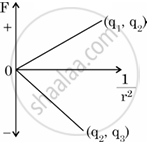
q1 > q2 > q3
q1 > q3 > q2
q3 > q2 > q1
q3 > q1 > q2
Chapter:
The magnetic susceptibility for a diamagnetic material is ______.
small and negative
small and positive
large and negative
large and positive
Chapter:
A circular loop A of radius R carries a current I. Another circular loop B of radius r`(= R/20)` is placed concentrically in the plane of A. The magnetic flux linked with loop B is proportional to ______.
R
`sqrtR`
`R^(3/2)`
R2
Chapter:
A particle of mass m and charge q is moving with velocity `vecv = v_xhati + v_yhatj`. If it is subjected to a magnetic field `vecB = B_0hati`, it will move in a ______.
straight line path
circular path
helical path
parabolic path
Chapter:
The quantum nature of light explains the observations on photoelectric effect as ______.
there is a minimum frequency of incident radiation below which no electrons are emitted.
the maximum kinetic energy of photoelectrons depends only on the frequency of incident radiation.
when the metal surface is illuminated, electrons are ejected from the surface after sometime.
the photoelectric current is independent of the intensity of incident radiation.
Chapter:
The phase difference between electric field `vecE` and magnetic field `vecB` in an electromagnetic wave propagating along z-axis is ______.
zero
π
`pi/2`
`pi/4`
Chapter:
The radius (rn) of nth orbit in Bohr model of hydrogen atom varies with n as ______.
rn ∝ n
`r_n ∝ 1/n`
rn ∝ n2
`r_n ∝ 1/n^2`
Chapter:
An ac source V = 282 sin (100 t) volt is connected across a 1 μF capacitor. The rms value of current in the circuit will be ______.
(take √2 = 1.41)
10 mA
20 mA
40 mA
80 mA
Chapter:
A galvanometer of resistance 100 Ω is converted into an ammeter of range (0 − 1 A) using a resistance of 0.1 Ω. The ammeter will show full scale deflection for a current of about ______.
0.1 mA
1 mA
10 mA
0.1 A
Chapter:
In Balmer series of hydrogen atom, as the wavelength of spectral lines decreases, they appear ______.
equally spaced and equally intense.
further apart and stronger in intensity.
closer together and stronger in intensity.
closer together and weaker in intensity.
Chapter:
A coil of N turns is placed in a magnetic field `vecB` such that `vecB` is perpendicular to the plane of the coil. `vecB` changes with time as `B = B_0 cos((2 pi)/T t)` where T is time period. The magnitude of emf induced in the coil will be maximum at
`t = (nT)/8` Here, n = 1, 2, 3, 4,...
`t = (nT)/4` Here, n = 1, 2, 3, 4,...
`t = (nT)/2` Here, n = 1, 2, 3, 4,...
t = nT Here, n = 1, 2, 3, 4,...
None of the above
Chapter:
Assertion (A): In interference and diffraction of light, light energy reduces in one region producing a dark fringe. It increases in another region and produces a bright fringe.
Reason (R): This happens because energy is not conserved in the phenomena of interference and diffraction.
If both Assertion (A) and Reason (R) are true and Reason (R) is the correct explanation of Assertion (A).
If both Assertion (A) and Reason (R) are true and Reason (R) is not the correct explanation of Assertion (A).
If Assertion (A) is true and Reason (R) is false.
If both Assertion (A) and Reason (R) are false.
Chapter:
Assertion (A): When electrons drift in a conductor, it does not mean that all free electrons in the conductor are moving in the same direction.
Reason (R): The drift velocity is superposed over large random velocities of electrons.
If both Assertion (A) and Reason (R) are true and Reason (R) is the correct explanation of Assertion (A).
If both Assertion (A) and Reason (R) are true and Reason (R) is not the correct explanation of Assertion (A).
If Assertion (A) is true and Reason (R) is false.
If both Assertion (A) and Reason (R) are false.
Chapter:
Assertion (A): Electrons are ejected from the surface of zinc when it is irradiated by yellow light.
Reason (R): Energy associated with a photon of yellow light is more than the work function of zinc.
If both Assertion (A) and Reason (R) are true and Reason (R) is the correct explanation of Assertion (A).
If both Assertion (A) and Reason (R) are true and Reason (R) is not the correct explanation of Assertion (A).
If Assertion (A) is true and Reason (R) is false.
If both Assertion (A) and Reason (R) are false.
Chapter:
Assertion (A): The temperature coefficient of resistance is positive for metals and negative for p-type semiconductors.
Reason (R): The charge carriers in metals are negatively charged, whereas the majority charge carriers in p-type semiconductors are positively charged.
If both Assertion (A) and Reason (R) are true and Reason (R) is the correct explanation of Assertion (A).
If both Assertion (A) and Reason (R) are true and Reason (R) is not the correct explanation of Assertion (A).
If Assertion (A) is true and Reason (R) is false.
If both Assertion (A) and Reason (R) are false.
Chapter:
An air bubble is trapped at point B (CB = 20 cm) in a glass sphere of radius 40 cm and refractive index 1.5 as shown in figure. Find the nature and position of the image of the bubble as seen by an observer at point P.

Chapter:
In normal adjustment, for a refracting telescope, the distance between objective and eye piece lens is 1.00 m. If the magnifying power of the telescope is 19, find the focal length of the objective and the eyepiece lens.
Chapter:
What are matter waves?
Chapter: [0.11] Dual Nature of Radiation and Matter
A proton, an electron and an α particle have the same kinetic energy. Write the de Broglie wavelengths associated with them in increasing order.
Chapter:
A ray of light is incident normally on one face of an equilateral glass prism of refractive index μ. When the prism is completely immersed in a transparent medium, it is observed that the emergent ray just grazes the adjacent face. Find the refractive index of the medium.
Chapter:
Two wires A and B of different metals have their lengths in ratio 1 : 2 and their radii in ratio 2 : 1 respectively. I-V graphs for them is shown in the figure. Find the ratio of their
- Resistances (RA/RB) and
- Resistivities (σA/σB)
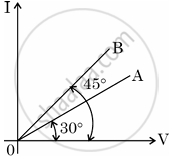
Chapter:
Draw the circuit diagram of a p-n junction diode in
- forward biasing and
- reverse biasing.
Also draw its I-V characteristics in the two cases.
Chapter:
Draw the graph showing variation of scattered particles detected (N) with the scattering angle (θ) in Geiger-Marsden experiment. Write two conclusions that you can draw from this graph. Obtain the expression for the distance of closest approach in this experiment.
Chapter:
Advertisements
A thin spherical conducting shell of radius R has a charge q. A point charge Q is placed at the centre of the shell. Find
- The charge density on the outer surface of the shell and
- the potential at a distance of (R/2) from the centre of the shell.
Chapter:
Differentiate between nuclear fission and nuclear fusion.
Chapter:
The fission properties of \[\ce{_94Pu^239}\] are very similar to those of \[\ce{_92U^235}\]. How much energy (in MeV), is released if all the atoms in 1 g of pure \[\ce{_94Pu^239}\] undergo fission? The average energy released per fission is 180 MeV.
Chapter:
Two long insulated straight wires carrying currents of 3 A and 5 A are arranged in XY plane as shown in figure. Find the magnitude and direction of the net magnetic fields at points P1(2m, 2m) and P2(−1m, 1m).
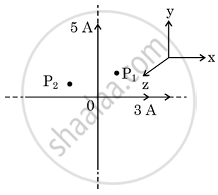
Chapter:
How is the displacement current different from the conduction current?
Chapter:
A capacitor is being charged by a source of emf. Justify the continuity of current in the circuit.
Chapter:
Find the currents flowing through the branches AB and BC in the network shown.
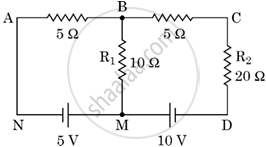
Chapter:
Define mutual inductance.
Chapter: [0.06] Electromagnetic Induction
Write the S.I. unit of mutual inductance.
Chapter: [0.06] Electromagnetic Induction
Derive an expression for the mutual inductance of a system of two long coaxial solenoids of same length l, having turns N1 and N2 and of radii r1 and r2 (> r1).
Chapter:
Explain ferromagnetism on the basis of the domain theory.
Chapter: [0.05] Magnetism and Matter
| A lens is a transparent optical medium bounded by two surfaces; at least one of which should be spherical. Applying the formula of image formation by a single spherical surface successively at the two surfaces of a thin lens, a formula known as lens maker’s formula and hence the basic lens formula can be obtained. The focal length (or power) of a lens depends on the radii of its surfaces and the refractive index of its material with respect to the surrounding medium. The refractive index of a material depends on the wavelength of light used. Combination of lenses helps us to obtain diverging or converging lenses of desired power and magnification. |
A thin converging lens of focal length 20 cm and a thin diverging lens of focal length 15 cm are placed coaxially in contact. The power of the combination is ______.
`(-5)/6D`
`(-5)/3D`
`4/3D`
`3/2D`
Chapter:
| A lens is a transparent optical medium bounded by two surfaces; at least one of which should be spherical. Applying the formula of image formation by a single spherical surface successively at the two surfaces of a thin lens, a formula known as lens maker’s formula and hence the basic lens formula can be obtained. The focal length (or power) of a lens depends on the radii of its surfaces and the refractive index of its material with respect to the surrounding medium. The refractive index of a material depends on the wavelength of light used. Combination of lenses helps us to obtain diverging or converging lenses of desired power and magnification. |
The radii of curvature of two surfaces of a convex lens are R and 2R. If the focal length of this lens is `(4/3)R`, the refractive index of the material of the lens is ______.
`5/3`
`4/3`
`3/2`
`7/5`
Chapter:
| A lens is a transparent optical medium bounded by two surfaces; at least one of which should be spherical. Applying the formula of image formation by a single spherical surface successively at the two surfaces of a thin lens, a formula known as lens maker’s formula and hence the basic lens formula can be obtained. The focal length (or power) of a lens depends on the radii of its surfaces and the refractive index of its material with respect to the surrounding medium. The refractive index of a material depends on the wavelength of light used. Combination of lenses helps us to obtain diverging or converging lenses of desired power and magnification. |
The focal length of an equiconvex lens ______.
increases when the lens is dipped in water.
increases when the wavelength of incident light decreases.
increases with decrease in radius of curvature of its surface.
decreases when the lens is cut into two identical parts along its |principal axis.
Chapter:
| A lens is a transparent optical medium bounded by two surfaces; at least one of which should be spherical. Applying the formula of image formation by a single spherical surface successively at the two surfaces of a thin lens, a formula known as lens maker’s formula and hence the basic lens formula can be obtained. The focal length (or power) of a lens depends on the radii of its surfaces and the refractive index of its material with respect to the surrounding medium. The refractive index of a material depends on the wavelength of light used. Combination of lenses helps us to obtain diverging or converging lenses of desired power and magnification. |
A thin convex lens L of focal length 10 cm and a concave mirror M of focal length 15 cm are placed coaxially 40 cm apart as shown in figure. A beam of light coming parallel to the principal axis is incident on the lens. The final image will be formed at a distance of ______.
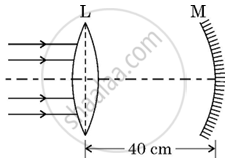
10 cm, left of lens
10 cm, right of lens
20 cm, left of lens
20 cm, right of lens
Chapter:
| A lens is a transparent optical medium bounded by two surfaces; at least one of which should be spherical. Applying the formula of image formation by a single spherical surface successively at the two surfaces of a thin lens, a formula known as lens maker’s formula and hence the basic lens formula can be obtained. The focal length (or power) of a lens depends on the radii of its surfaces and the refractive index of its material with respect to the surrounding medium. The refractive index of a material depends on the wavelength of light used. Combination of lenses helps us to obtain diverging or converging lenses of desired power and magnification. |
A beam of light coming parallel to the principal axis of a convex lens L1 of focal length 16 cm is incident on it. Another convex lens L2 of focal length 12 cm is placed coaxially at a distance 40 cm from L1. The nature and distance of the final image from L2 will be ______.
real, 24 cm
virtual, 12 cm
real, 32 cm
virtual, 18 cm
Chapter:
| A pure semiconductor like \[\ce{Ge}\] or \[\ce{Si}\], when doped with a small amount of suitable impurity, becomes an extrinsic semiconductor. In thermal equilibrium, the electron and hole concentration in it are related to the concentration of intrinsic charge carriers. A p-type or n-type semiconductor can be converted into a p-n junction by doping it with suitable impurity. Two processes, diffusion and drift take place during formation of a p-n junction. A semiconductor diode is basically a p-n junction with metallic contacts provided at the ends for the application of an external voltage. A p-n junction diode allows currents to pass only in one direction when it is forward biased. Due to this property, a diode is widely used to rectify alternating voltages, in half-wave or full wave configuration. |
When \[\ce{Ge}\] is doped with pentavalent impurity, the energy required to free the weakly bound electron from the dopant is about ______.
0.001 eV
0.01 eV
0.72 eV
1.1 eV
Chapter:
| A pure semiconductor like \[\ce{Ge}\] or \[\ce{Si}\], when doped with a small amount of suitable impurity, becomes an extrinsic semiconductor. In thermal equilibrium, the electron and hole concentration in it are related to the concentration of intrinsic charge carriers. A p-type or n-type semiconductor can be converted into a p-n junction by doping it with suitable impurity. Two processes, diffusion and drift take place during formation of a p-n junction. A semiconductor diode is basically a p-n junction with metallic contacts provided at the ends for the application of an external voltage. A p-n junction diode allows currents to pass only in one direction when it is forward biased. Due to this property, a diode is widely used to rectify alternating voltages, in half-wave or full wave configuration. |
At a given temperature, the number of intrinsic charge carriers in a semiconductor is 2.0 × 1010 cm−3. It is doped with pentavalent impurity atoms. As a result, the number of holes in it becomes 8 × 103 cm−3. The number of electrons in the semiconductor is ______.
2 × 1024 m−3
4 × 1023 m−3
1 × 1022 m−3
5 × 1022 m−3
Chapter:
| A pure semiconductor like \[\ce{Ge}\] or \[\ce{Si}\], when doped with a small amount of suitable impurity, becomes an extrinsic semiconductor. In thermal equilibrium, the electron and hole concentration in it are related to the concentration of intrinsic charge carriers. A p-type or n-type semiconductor can be converted into a p-n junction by doping it with suitable impurity. Two processes, diffusion and drift take place during formation of a p-n junction. A semiconductor diode is basically a p-n junction with metallic contacts provided at the ends for the application of an external voltage. A p-n junction diode allows currents to pass only in one direction when it is forward biased. Due to this property, a diode is widely used to rectify alternating voltages, in half-wave or full wave configuration. |
During the formation of a p-n junction ______.
electrons diffuse from p-region into n-region and holes diffuse from n-region into p-region.
both electrons and holes diffuse from n-region into p-region.
electrons diffuse from n-region into p-region and holes diffuse from p-region into n-region.
both electrons and holes diffuse from p-region into n-region.
Chapter:
Advertisements
| A pure semiconductor like \[\ce{Ge}\] or \[\ce{Si}\], when doped with a small amount of suitable impurity, becomes an extrinsic semiconductor. In thermal equilibrium, the electron and hole concentration in it are related to the concentration of intrinsic charge carriers. A p-type or n-type semiconductor can be converted into a p-n junction by doping it with suitable impurity. Two processes, diffusion and drift take place during formation of a p-n junction. A semiconductor diode is basically a p-n junction with metallic contacts provided at the ends for the application of an external voltage. A p-n junction diode allows currents to pass only in one direction when it is forward biased. Due to this property, a diode is widely used to rectify alternating voltages, in half-wave or full wave configuration. |
Initially during the formation of a p-n junction ______.
diffusion current is large and drift current is small.
diffusion current is small and drift current is large.
both the diffusion and the drift currents are large.
both the diffusion and the drift currents are small.
Chapter:
| A pure semiconductor like \[\ce{Ge}\] or \[\ce{Si}\], when doped with a small amount of suitable impurity, becomes an extrinsic semiconductor. In thermal equilibrium, the electron and hole concentration in it are related to the concentration of intrinsic charge carriers. A p-type or n-type semiconductor can be converted into a p-n junction by doping it with suitable impurity. Two processes, diffusion and drift take place during formation of a p-n junction. A semiconductor diode is basically a p-n junction with metallic contacts provided at the ends for the application of an external voltage. A p-n junction diode allows currents to pass only in one direction when it is forward biased. Due to this property, a diode is widely used to rectify alternating voltages, in half-wave or full wave configuration. |
An ac voltage V = 0.5 sin (100 πt) volt is applied, in turn, across a half-wave rectifier and a full-wave rectifier. The frequency of the output voltage across them respectively will be ______.
25 Hz, 50 Hz
25 Hz, 100 Hz
50 Hz, 50 Hz
50 Hz, 100 Hz
Chapter:
Mention the factors on which the resonant frequency of a series LCR circuit depends. Plot a graph showing variation of impedance of a series LCR circuit with the frequency of the applied a.c. source.
Chapter:
With the help of a suitable diagram, explain the working of a step-up transformer.
Chapter:
Write two causes of energy loss in a real transformer.
Chapter:
Explain the construction and working of an electric generator (AC) with the help of a neat diagram.
Chapter:
An electron is revolving around a proton in an orbit of radius r with a speed v. Obtain expression for magnetic moment associated with the electron.
Chapter:
A dielectric slab of dielectric constant ‘K' and thickness ‘t' is inserted between plates of a parallel plate capacitor of plate separation d and plate area A. Obtain an expression for its capacitance.
Chapter:
Two capacitors of different capacitances are connected first
- in series and then
- in parallel across a dc source of 100 V.
If the total energy stored in the combination in the two cases are 40 mJ and 250 mJ respectively, find the capacitance of the capacitors.
Chapter:
Using Gauss’s law, show that the electric field `vecE` at a point due to a uniformly charged infinite plane sheet is given by `vecE = sigma/(2epsilon_0)hatn` where symbols have their usual meanings.
Chapter:
Electric field `vecE` in a region is given by
`vecE = (5x^2 + 2)hati`
where E is in N/C and x is in meters.
A cube of side 10 cm is placed in the region as shown in figure.
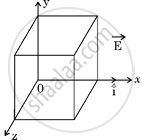
Calculate
- the electric flux through the cube, and
- the net charge enclosed by the cube.
Chapter:
Draw a ray diagram for the formation of the image of an object by a convex mirror. Hence, obtain the mirror equation.
Chapter:
Why are multi-component lenses used for both the objective and the eyepiece in optical instruments?
Chapter:
The magnification of a small object produced by a compound microscope is 200. The focal length of the eyepiece is 2 cm and the final image is formed at infinity. Find the magnification produced by the objective.
Chapter:
State Huygen’s principle and verify laws of reflection using suitable diagram.
Chapter:
In Young's double slit experiment, the slits S1 and S2 are 3 mm apart and the screen is placed 1.0 m away from the slits. It is observed that the fourth bright fringe is at a distance of 5 mm from the second dark fringe. Find the wavelength of light used.
Chapter:
Other Solutions
Submit Question Paper
Help us maintain new question papers on Shaalaa.com, so we can continue to help studentsonly jpg, png and pdf files
CBSE previous year question papers Class 12 Physics with solutions 2023 - 2024
Previous year Question paper for CBSE Class 12 Physics-2024 is solved by experts. Solved question papers gives you the chance to check yourself after your mock test.
By referring the question paper Solutions for Physics, you can scale your preparation level and work on your weak areas. It will also help the candidates in developing the time-management skills. Practice makes perfect, and there is no better way to practice than to attempt previous year question paper solutions of CBSE Class 12.
How CBSE Class 12 Question Paper solutions Help Students ?
• Question paper solutions for Physics will helps students to prepare for exam.
• Question paper with answer will boost students confidence in exam time and also give you an idea About the important questions and topics to be prepared for the board exam.
• For finding solution of question papers no need to refer so multiple sources like textbook or guides.
